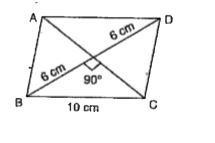The perimeter of a rhombus is 20 cm. The length of one of its diagonal is 6 cm. What is the length of the other diagonal ?
6 cm
9 cm
8 cm
10 cm
The correct Answer is:C
To solve the problem step-by-step, we need to find the length of the other diagonal of the rhombus given its perimeter and one diagonal.
Step 1: Understand the properties of a rhombus
A rhombus has four equal sides and its diagonals bisect each other at right angles (90 degrees).
Step 2: Calculate the length of one side of the rhombus
The perimeter of the rhombus is given as 20 cm. Since all sides are equal, we can find the length of one side (s) using the formula for the perimeter of a rhombus:
Perimeter=4s
So,
4s=20⟹s=204=5 cm
Step 3: Set up the relationship between the diagonals
Let the length of the diagonals be d1 and d2. We know that one diagonal d1=6 cm. The diagonals bisect each other, so each half of the diagonals will be:
AO=d12=62=3 cm
Let d2 be the other diagonal, then:
BO=d22
Step 4: Use the Pythagorean theorem
In triangle AOB, we can apply the Pythagorean theorem since the diagonals intersect at right angles:
AB2=AO2+BO2
Substituting the known values:
52=32+(d22)2
This simplifies to:
25=9+(d22)2
25−9=(d22)2
16=(d22)2
Step 5: Solve for d2
Taking the square root of both sides:
d22=4⟹d2=8 cm
Conclusion
The length of the other diagonal d2 is 8 cm.
A rhombus has four equal sides and its diagonals bisect each other at right angles (90 degrees).
The perimeter of the rhombus is given as 20 cm. Since all sides are equal, we can find the length of one side (s) using the formula for the perimeter of a rhombus:
Perimeter=4s
So,
4s=20⟹s=204=5 cm
Let the length of the diagonals be d1 and d2. We know that one diagonal d1=6 cm. The diagonals bisect each other, so each half of the diagonals will be:
AO=d12=62=3 cm
Let d2 be the other diagonal, then:
BO=d22
In triangle AOB, we can apply the Pythagorean theorem since the diagonals intersect at right angles:
AB2=AO2+BO2
Substituting the known values:
52=32+(d22)2
This simplifies to:
25=9+(d22)2
25−9=(d22)2
16=(d22)2
Taking the square root of both sides:
d22=4⟹d2=8 cm
The length of the other diagonal d2 is 8 cm.
Similar Questions
The perimeter of a rhombus is 40 cm. If the length of one of its diagonal is 10 cm, what is the length of the other diagonal?
 View Solution
View SolutionThe perimeter of a rhombus is 20 cm. The length of its one of the diagonals is 6 cm Find the length of the other diagonal .
किसी समचतुर्भुज की परिमाप 20 cm है | इसके एक विकर्ण की लम्बाई 6 cm है | दूसरे विकर्ण की लम्बाई कितनी है?View Solution
Knowledge Check
- Question 1 - Select One
The perimeter of a rhombus is 40 cm. If the length of one of its diagonals be 12 m, then the length of the other diagonal is
A14 cmB15 cmC16 cmD12 cm - Question 2 - Select One
If the perimeter of a rhombus is 56 cm and the length of one of its diagonals is 26 cm. then find the length of the other diagonal of the rhombus.
A)6√7 cm
B)6√5 cm
C)6√3 cm
D)6√2 cmA6√7 cmB6√5 cmC6√3 cmD6√2 cm - Question 3 - Select One
The area of a rhombus is 150cm2. The length of one of its diagonals is 10 cm. The length of the other diagonal is :
A25 cmB30 cmC35 cmD40 cm
The area of a rhombus is 150 cm2. The length of one of its diagonal is 10 cm. What is the length of the other diagonal ?
View SolutionIf one side of a rhombus if 17 cm and length of one of its diagonals is 16 cm. What is the length of other diagonal (incm)?
View SolutionThe area of a rhombus is 132 cm2. If length of one of its diagonals is 11 cm, then what is the length of the other diagonal?
View SolutionThe perimeter of a rhombus is 164 cm. If the length of one of the diagonals is 18 cm, find the length of ither diagonal. Hence, find the area of the rhombus
View SolutionThe area of a rhombus is 150 cm2. The length of one of its diagonals is 10 cm. The length of the other diagonal is (a) 25 cm (b) 30 cm (c) 35 cm (d) 40 cm
View Solution

